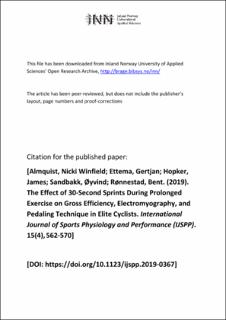The Effect of 30-Second Sprints During Prolonged Exercise on Gross Efficiency, Electromyography, and Pedaling Technique in Elite Cyclists
Peer reviewed, Journal article
Accepted version
Permanent lenke
https://hdl.handle.net/11250/2684808Utgivelsesdato
2019Metadata
Vis full innførselSamlinger
Originalversjon
International Journal of Sports Physiology and Performance (IJSPP). 2019 10.1123/ijspp.2019-0367Sammendrag
Background: Cycling competitions are often of long duration and include repeated high-intensity efforts. Purpose: To investigate the effect of repeated maximal sprints during 4 hours of low-intensity cycling on gross efficiency (GE), electromyography patterns, and pedaling technique compared with work-matched low-intensity cycling in elite cyclists. Methods: Twelve elite, male cyclists performed 4 hours of cycling at 50% of maximal oxygen uptake either with 3 sets of 3 × 30-second maximal sprints (E&S) during the first 3 hours or a work-matched cycling without sprints (E) in a randomized order. Oxygen uptake, electromyography, and pedaling technique were recorded throughout the exercises. Results: GE was reduced from start to the end of exercise in both conditions (E&S: 19.0 [0.2] vs 18.1 [0.2], E: 19.1% [0.2%] vs 18.1% [0.2%], both P = .001), with no difference in change between conditions (condition × time interaction, P = .8). Integrated electromyography increased from start to end of exercise in m. vastus lateralis and m. vastus medialis (m. vastus medialis: 9.9 [2.4], m. vastus lateralis: 8.5 [4.0] mV, main effect of time: P < .001 and P = .03, respectively) and E&S increased less than E in m. vastus medialis (mean difference −3.3 [1.5] mV, main effect of condition: P = .03, interaction, P = .06). The mechanical effectiveness only decreased in E&S (E&S: −2.2 [0.7], effect size = 0.24 vs E: −1.3 [0.8] percentage points: P = .04 and P = .8, respectively). The mean power output during each set of 3 × 30-second sprints in E&S did not differ (P = .6). Conclusions: GE decreases as a function of time during 4 hours of low-intensity cycling. However, the inclusion of maximal repeated sprinting does not affect the GE changes, and the ability to sprint is maintained throughout the entire session.
Beskrivelse
© 2019-2020 Human Kinetics
